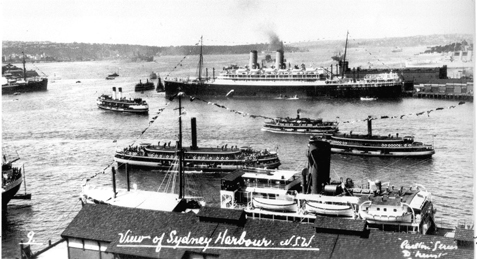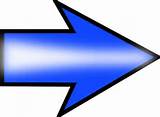|
-15-

Circular
Quay/Sydney Cove as it was c.1922, when Lawrence arrived
(on much the same
boat as the one shown, tied up at the P&O wharf, where
the Malwa
berthed on May 27, 1922). Lawrence would have caught several
ferries
like these from "the Quay" on his various Harbour
excursions
to Mosman, Manly, Cremorne, etc.
TOWARDS
THE END of 1976 - my research annus mirabilis
- the main focus of the research was switching from
what had happened to how it had happened.
My immediate challenge was to place Jack Scott and Lawrence
in the same place at the same time - somewhere in Sydney
during the first week or so Lawrence was there (and
thus afford Lawrence with the opportunity learn about
the secret army).
Yet on the face of things, scheduling such a meeting
should not have posed an insurmountable difficulty.
For in Kangaroo Lawrence himself was recording,
in his "fictionalised diary", how these things
came about. The answer - all the answers - had to be
found hidden in the text of the novel.
My task was to unravel the tangled skein of narrative
and separate what was based on fact and what on artistic
inspiration, or embellishment. I had to strip away the
"fictionalisation" and expose the factual
foundations that lay, I was convinced, beneath.
One
of the first clues to how it happened came in a letter
from someone in Melbourne - his name was Ernest Whiting
- who had read my "Mystery of Kangaroo"
article in The Australian in mid-1976.
He told me that he knew I was right - Kangaroo
was based on fact.
He knew this, he told me, because of a conversation he
remembered having overheard as a youth at one of his mother's
literary soirees in Melbourne in the late 1930s. His mother
was the daughter of the Australian poet, AB "Banjo"
Patterson.
He remembered that one of her soiree guests, a leading
business figure, had revealed to the gathering that Lawrence
had run across an actual secret army in Sydney in 1922.
When asked how such an unlikely event could have occurred,
the business figure had replied, according to Ernest Whiting:
"To know the answer to that question you must consult
the passenger list of the boat that brought Lawrence to
Sydney."
And it is here that I should introduce another of the
heroes in the long search for the truth about Lawrence
and Kangaroo - the Quest for Cooley. His name is
John Ruffels, and if Andrew Moore became my Huxley, then
John was my Watson, though immeasurably smarter than Holmes's
stolid companion.
While I was working as a journalist in London, John -
a postman by profession - was my willing and skilled research
assistant in Sydney. His abilities as a researcher proved
to be of Bletchleyesque proportions.
He, energetically, took on the task of tracking down who
could have been on "the boat that brought Lawrence
to Sydney" who might have led Lawrence to Scott and
Rosenthal.
Three boats brought Lawrence and Frieda to Sydney - the
Osterley from Naples to Colombo, the Orsova
from Colombo to Perth, and the Malwa from Perth
to Sydney.
John obtained the passenger lists of each boat - comprising
hundreds of names - and began sifting through them, trying
to find who might have been Lawrence's original "contact"
with the secret army.

|
|